September Fungi Focus: Hairy Nuts Disco (Lanzia echinophila)

And whoosh, just like that, the whole country changed… After the hottest, driest, summer on record, last Friday the rains finally broke over my parched little corner of the garden of England, transforming the woodlands into a veritable fungal jungle.
Much of the joy in going out on regular photographic forays for mushrooms and toadstools for me comes from monitoring the changes in what can be found in specific sites across the seasons. You can head out several times a week and still find things that have popped up since your last visit, while previous finds can disappear without a trace as quickly as they appeared. There’s a definite fear of missing out on some exciting development or potential discovery when I don’t visit my local woods for a while.
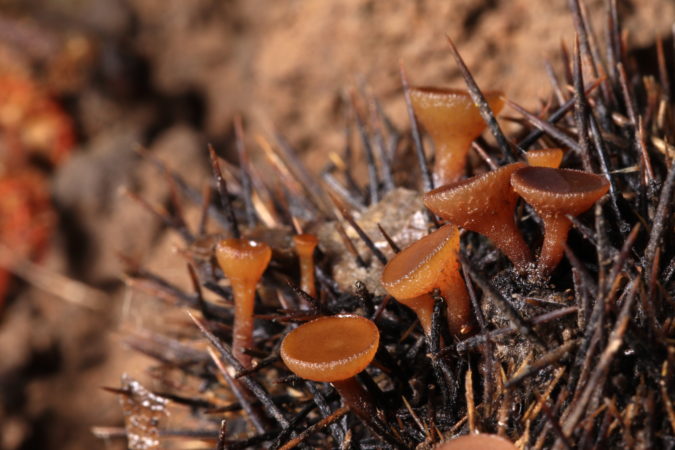
Hairy Nuts Disco
My typical pattern is that I will head out and if I find something new that I’ve not seen yet that season, I will take a photograph of it, recording where and when I first noted its appearance for that year. I generally find around half a dozen or so different species on each trip, but rarely do I return having found nothing, no matter what the time of year, no matter how hot, cold, wet or dry it is.
In this sense, I personally find fungi more interesting than plants, in that the number of species in a given wooded environment is far larger but it is very difficult to gauge much of what is there. Whereas the likes of ferns, brambles, bluebells, anemones etc, first emerge and grow relatively slowly, lingering for several months before dying back, most fungi just pop up and disappear within a matter of days. For much of the year they remain invisible as mycelium within their given substrate, with their fruiting bodies popping up in the form of mushrooms and toadstools so quickly that you have to be sure you’re around to catch the moment. Even something as massive and substantial as a Dryad’s Saddle (Cerioporus squamosus), a large bracket reaching up to a meter across with pores beneath and a characteristic hen pheasant pattern on its topside, can come and be gone within a matter of weeks.
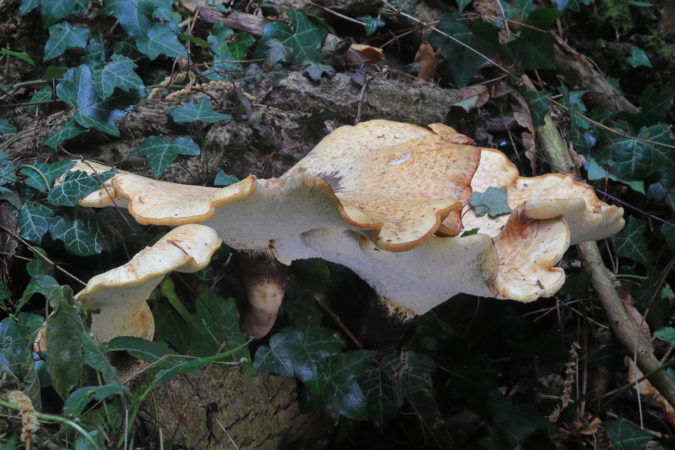
The Dryad’s Saddle (Cerioporus squamosus) can come and be gone within a matter of weeks.
The early autumn period, which marks the beginning of the peak season for mushroom hunters, then, comes as something of a mixed blessing. While it’s hugely exciting seeing fungi that have been hidden underground or within dead wood manifesting their true colours for the first time, it’s almost overwhelming how much new stuff there is to take stock of.
My woodland wander last Saturday, 10th September, reacquainted me with a plethora of perennial favourites I’d not seen for many, many months: Green Elfcups, Deer Shields, Oysterlings, Collared Parachutes, and numerous members of the Mycena genus. The most dramatic find, however, was a species that I’d not encountered before UK Fungus Day, on 2nd October of last year, during one of my first explorations of the woods nearby to the new home I’d just moved to, where I spied a tiny cluster of tiny brown cups nestling amongst the spines of a damp chestnut husk lying on the ground.
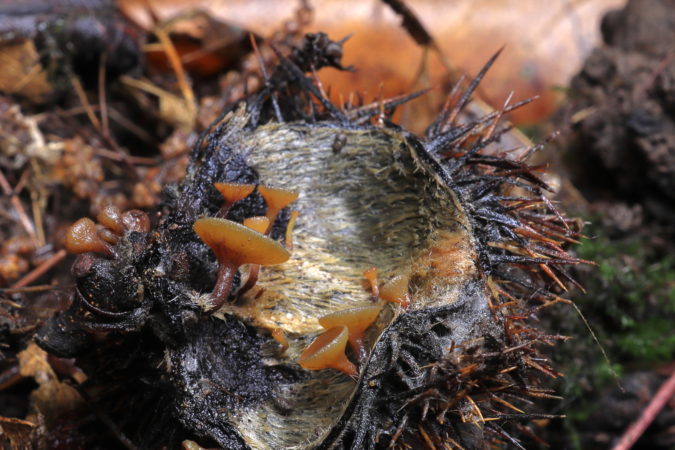
Hairy Nuts Disco
This specific host made identification a relatively straightforward matter. I’d found my first ever Lanzia echinophila, blessed with one of the most colourful monickers ever granted by those entrusted with coming up with the English common names listed by the British Mycological Society: the Hairy Nuts Disco.
I must have come fairly late to the game last Autumn, however, if the amount I found after last week’s torrential downpours were anything to go by. Vast numbers of these tiny cups sprouted from every single one of the prickly decaying husks covering the ground (the “echinophila” part of its name means “spine-loving”).
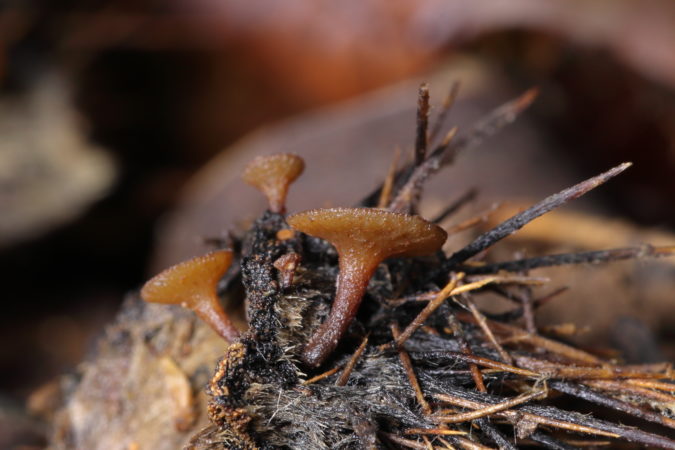
Hairy Nuts Disco
I’m not sure how common this species might be, as they are don’t seem to be listed in the otherwise exhaustive Fungi of Temperate Europe, but Peter Thompson’s Ascomycetes in Colour describes them as restricted to the rotting cupules of sweet chestnut (Castanea sativa), a tree which dominates the local woodlands of East Kent where it has been traditionally coppiced for use as gate poles and the like. Many of my local woodlands follow the model described in this previous Woodlands post on chestnut coppicing, with oak dotted amongst them, as well as a good number of hazel trees, also once coppiced extensively for use as hop-poles in the hop-growing heartlands of Kent. Many of the mixed deciduous woodlands in the area with chestnut, hazel and oak predominating are now in private hands, and no longer worked commercially, though some still are.
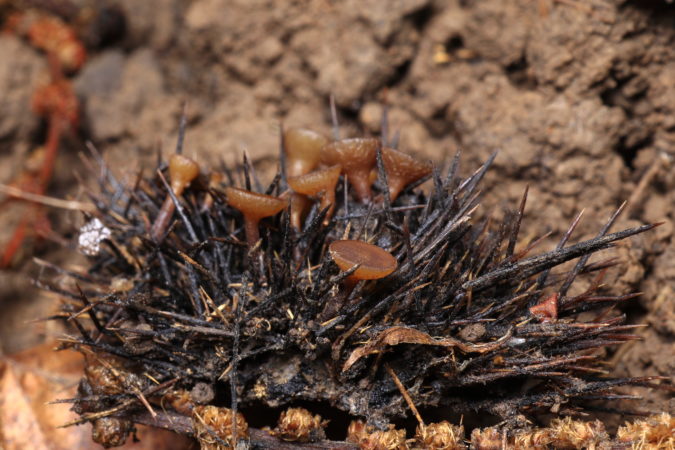
Hairy Nuts Disco
I would be curious to learn just how common a find Hairy Nuts Discos are across the United Kingdom. I found just one record on the The Fungal Records Database of Britain and Ireland (FRDBI), from September 2017 in Surrey, near Leatherhead, but there are a few more on iRecord, mostly from Sussex and Kent. These kind of things are probably not likely to be registered unless one is actively looking at chestnut husks, something which mushroom foragers in search of edibles are not likely to be doing.
In any case, the cups are relatively small, around 2-3mm in diameter, although can grow considerably larger to around a 1cm across, and the combination of the reddish brown colouration of the fertile hymenium inside the cup and the slightly lighter margins and stalk does make them rather blend in amongst the spikes. There are other small discomycetes fungi (i.e. disc-shaped ascomycetes) that can be found growing on fallen chestnut husks – I mentioned in passing the yellowish Hymenoscyphus serotinus in a post from June on the various lookalikes for fungus responsible for Ash Dieback, Hymenoscyphus fraxineus, as an example of the kind of thing the eagle eyed might spot rummaging around the forest litter.
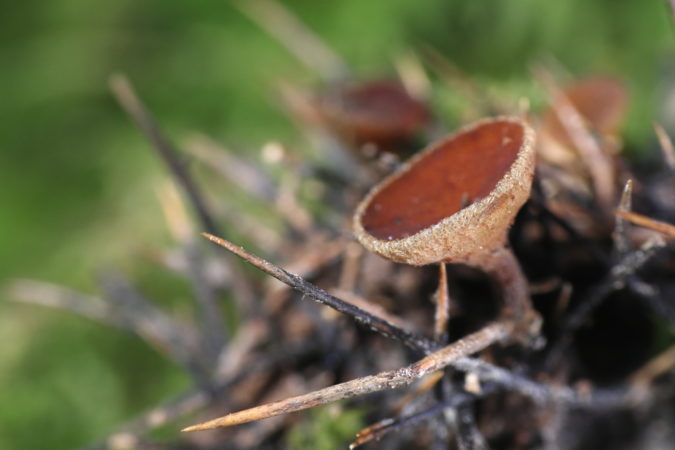
Hairy Nuts Disco
I’m still not entirely sure whether the name, memorable as it may be, describes this species particularly well, as these tiny fruit bodies aren’t particularly hairy, although there is a slightly fibrous texture to the outsides. That said, Hairy Nuts Discos are unlikely to be mistaken for anything else once you know what it is, so if you notice them while scavenging for chestnuts this autumn, please do post a comment here so we might get a better idea of how prevalent they are across the country.
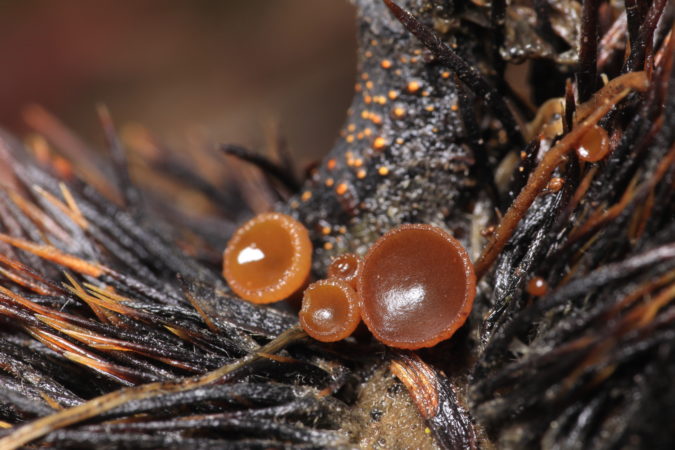
Hairy Nuts Disco
Comments are closed for this post.

Found a few two weeks back foraging in SE London/edges of Kent! Intriguing. Thank you for the blog!
Lucy
23 September, 2022